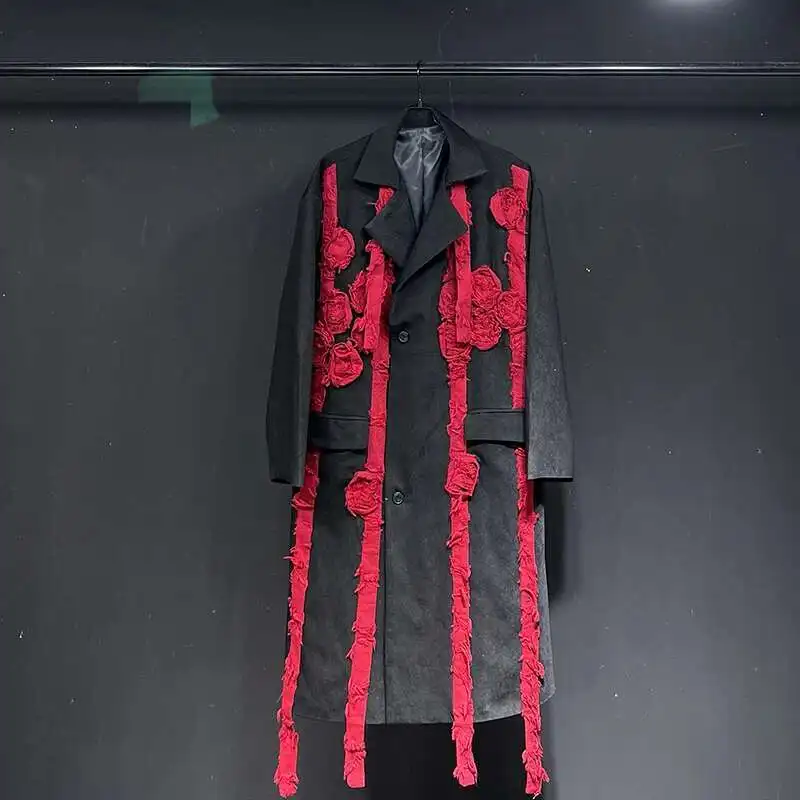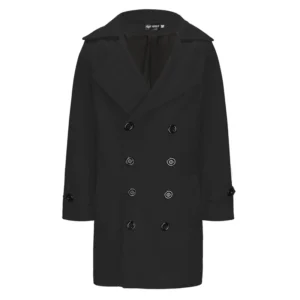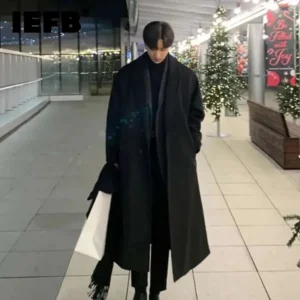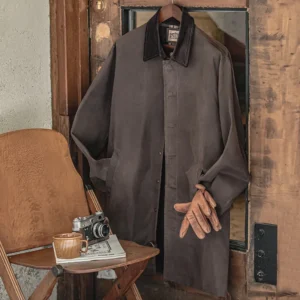Introduction: Understanding Coat Patterns
When it comes to men’s outerwear, the pattern of your coat makes a powerful statement about your personal style. Herringbone and plaid stand as two of the most enduring and distinguished patterns in the world of quality coats. Herringbone features a distinctive v-shaped weaving pattern resembling fish bones, creating subtle visual texture. Plaid, on the other hand, consists of intersecting horizontal and vertical bands in various colors and widths, offering everything from understated elegance to bold visual impact.
Selecting between these classic patterns involves more than just aesthetics—it’s about making a thoughtful investment in your wardrobe. The right pattern complements your existing style while providing versatility across different occasions. Both herringbone and plaid have centuries of history in textile production, evolving from functional origins to become style signatures adopted by everyone from rural workers to royalty.
As we explore the distinct characteristics of each pattern, you’ll gain insight into how choosing the right coat length and pattern can transform your outerwear collection. This guide will take you through detailed pattern descriptions, practical styling advice, and considerations to help you determine which timeless design best suits your personal style and needs.
The Definitive Comparison: Herringbone vs. Plaid at a Glance
Before diving deeper into each pattern’s unique characteristics, let’s examine how herringbone and plaid stack up against each other across key attributes:
| Feature | Herringbone | Plaid |
|---|---|---|
| Visual Structure | V-shaped zigzag pattern | Intersecting horizontal and vertical bands |
| Weave Construction | Broken twill weave | Varies by plaid type (plain weave, twill, etc.) |
| Formality | Medium to high formality | Varies widely (Glen plaid: formal; Buffalo check: casual) |
| Common Materials | Wool, tweed, cashmere blends | Wool, tweed, flannel, cotton |
| Color Variations | Usually monochromatic or subtle two-tone | Multiple colors, from subtle to bold combinations |
| Pattern Scale | Typically consistent, medium to small scale | Varies from tiny checks to large-scale blocks |
| Overall Aesthetic | Refined, textured, understated | Ranges from sophisticated to rustic depending on variety |
| Best Uses | Business, formal events, versatile daily wear | Varies by type (business to outdoor casual) |
While both patterns have earned their place in classic menswear, they differ fundamentally in structure and impact. Herringbone offers a consistent sophistication with its uniform texture, while plaid provides remarkable variety through its numerous variations. The herringbone overcoat represents timeless elegance, while a tartan peacoat might convey heritage and bold character.
Men exploring our herringbone coat collection often appreciate the pattern’s refined texture that adds interest without overwhelming an outfit. Meanwhile, plaid’s versatility comes from its many variations—from the subtle windowpane check to the statement-making tartan.
Herringbone Pattern: The Elegant Classic
Herringbone is defined by its distinctive broken twill weave that creates a series of small, connected v-shapes resembling fish bones (hence the name). Unlike simple stripes or checks, herringbone has a sophisticated visual depth that catches light differently across its surface, creating subtle movement and dimension even in solid colors.
Distinctive Characteristics
What sets herringbone apart is its remarkable balance between visual interest and versatility. The pattern typically appears in a single color with varying shades creating the visible texture. This subtlety allows herringbone to function almost like a solid color from a distance, while revealing its refined complexity up close.
The pattern is most commonly found in wool coats, where the natural fiber’s texture enhances the pattern’s definition. Premium herringbone coats often use higher-grade wools, cashmere blends, or tweed variations that add further character to the weave.
Herringbone projects a sophisticated, refined image with deep roots in British tailoring traditions. The pattern became a staple in gentleman’s overcoats and suits during the early 20th century, establishing its association with classical style and good taste.
Understanding what length coat makes you taller can be just as important as selecting the right pattern, as herringbone’s vertical elements can actually enhance height when properly proportioned. The pattern’s subtle nature allows it to work across multiple coat styles, from fitted peacoats to flowing overcoats, adapting seamlessly to different silhouettes.
Plaid Pattern: The Varied Tradition
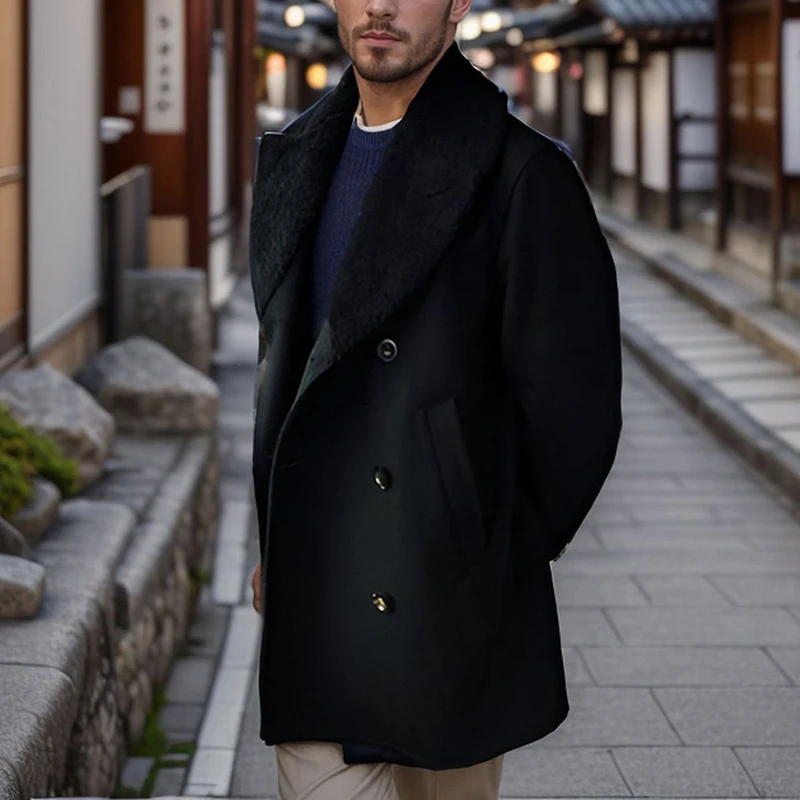
Plaid represents not a single pattern but a diverse family of designs unified by their intersecting horizontal and vertical bands of color. This variety gives plaid remarkable range—from subtle, sophisticated checks to bold statement patterns.
Key Plaid Variations
Tartan: Perhaps the most recognizable plaid variation, tartan features colorful intersecting bands in specific combinations that historically identified Scottish clans. Modern tartans range from traditional color schemes (often featuring reds, greens, and blues) to contemporary interpretations. These patterns carry cultural significance while offering rich visual texture.
Glen Plaid (Prince of Wales): This more subdued pattern consists of small and large checks creating a woven appearance in usually neutral tones. Made famous by the Duke of Windsor in the 1930s, Glen plaid strikes a perfect balance between pattern interest and formality, making it suitable for business environments.
Windowpane: This minimalist plaid features widely-spaced lines forming large, window-like rectangles on a solid background. Its clean, architectural appearance offers pattern interest without overwhelming the garment, making it one of the more conservative plaid options.
Buffalo Check: Characterized by large blocks of typically red and black (though other color combinations exist), this bold pattern has roots in outdoor workwear but has become a casual fashion staple. Its large scale and high contrast create a more casual, rugged appearance.
The diverse world of plaid patterns means they can convey anything from aristocratic refinement to rugged outdoor spirit. For those interested in exploring this pattern further, our guide on understanding herringbone coat patterns offers useful comparative insights.
Unlike herringbone’s consistent character, plaid’s versatility stems from its variations—each telling a different style story and suitable for different occasions. This diversity makes plaid both more expressive and more specific in its applications.
Material Matters: How Fabric Affects Pattern Expression
The way herringbone and plaid patterns appear depends significantly on the fabric used. The same pattern can look dramatically different depending on material weight, texture, and construction.
Heavy Wool
Heavy wool provides structure that allows both patterns to display with crisp definition. In herringbone, heavyweight wool emphasizes the v-shaped texture through shadow and dimension. For plaid, it creates clear demarcation between color blocks and lines. These fabrics typically appear in winter overcoats, providing both warmth and pattern integrity.
Tweed
Tweed’s nubby, textured surface adds rustic character to both patterns. Herringbone tweed becomes more three-dimensional, with the pattern seeming to rise from the fabric surface. Plaid tweeds gain additional color complexity from the yarn’s natural flecking. This material is particularly well-suited to country-inspired coat styles with elbow patches and ticket pockets.
Cashmere
Cashmere softens pattern definitions, creating a more luxurious, subtle expression. Herringbone in cashmere appears more fluid, with gentle transitions between the v-shapes. Plaid cashmere coats display more blended color transitions with less sharp definition, resulting in a softer, more elegant appearance.
Wool Blends
Modern wool overcoats often use blends that balance durability, comfort, and pattern definition. These blends can be engineered to enhance certain qualities of either pattern—creating sharper definition for business-appropriate coats or softening lines for more casual styles.
Material weight also affects seasonality—lightweight wool herringbone and plaid patterns work for transitional seasons, while heavier versions provide winter warmth. Understanding these material interactions helps you select not just the right pattern, but the right expression of that pattern for your needs.
Styling Guide: Herringbone Coats
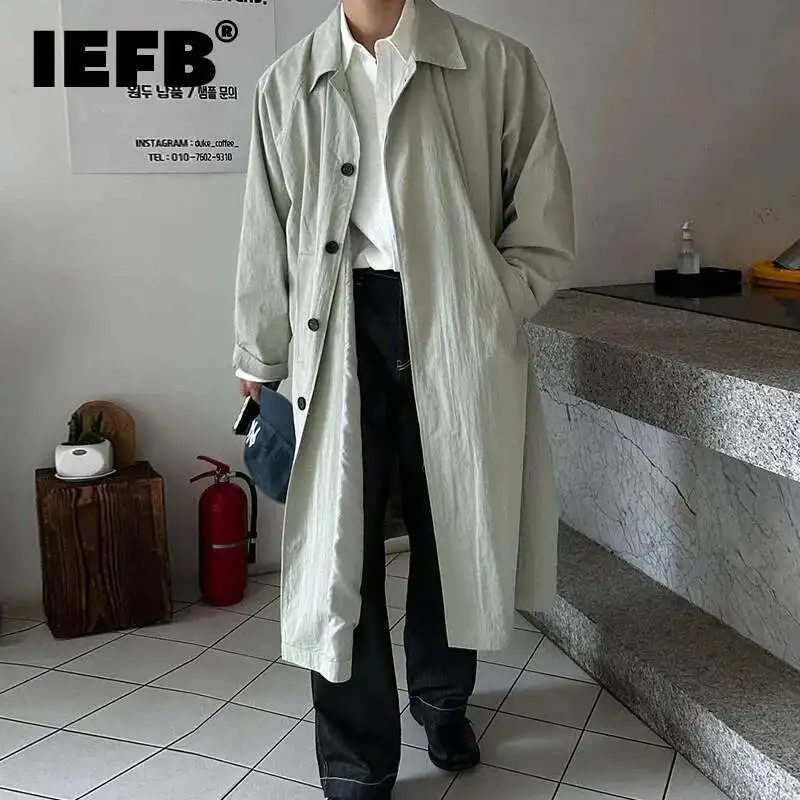
Herringbone coats offer remarkable versatility across different dress codes, making them excellent investment pieces. Their subtle pattern provides texture without limiting outfit combinations.
For business settings, pair a gray or navy herringbone overcoat with solid-colored suits or trousers. The pattern adds refined visual interest without competing with other elements of your outfit. A charcoal herringbone coat works particularly well with navy suits, creating sophisticated tonal contrast.
For smart casual occasions, herringbone coats pair excellently with solid knitwear—try a camel herringbone coat over a cream turtleneck and dark trousers for an elegant weekend look. The textured pattern also complements dark denim remarkably well, creating an elevated casual ensemble.
Color coordination is straightforward with herringbone coats as they typically come in neutral tones like gray, brown, navy, or camel. These shades work with most color palettes, though complementary colors often yield the most sophisticated results.
Accessories that work particularly well with herringbone include solid scarves (which don’t compete with the pattern), leather gloves, and structured hats. For a complete understanding of when this pattern works best, explore whether herringbone is formal or casual in different contexts.
Styling Guide: Plaid Coats
Styling plaid coats requires consideration of the specific plaid variety, as each type projects a different character and formality level.
For subtle plaids like Glen check or windowpane patterns, treat the coat similarly to herringbone—these designs work well in professional settings when paired with solid suits or trousers. A navy Glen plaid overcoat complements gray flannel trousers and a light blue shirt for a refined business look.
For more pronounced plaids like traditional tartans, balance is key. Let the coat be the focal point of your outfit by pairing it with solid, complementary colors drawn from the plaid itself. A classic Black Watch tartan coat (navy and green) pairs beautifully with solid navy trousers and a cream sweater.
Buffalo check and larger-scale plaids tend toward casual styling—these bold patterns work with simple, rugged outfits like jeans and chunky knitwear for weekend or outdoor-inspired looks.
When selecting plaid scale, consider your body type: larger men generally benefit from medium to larger scale patterns, while smaller frames may be overwhelmed by very large checks. Our tweed coat collection offers excellent examples of how different plaid scales appear on finished garments.
Avoid the common mistake of competing patterns—when wearing a plaid coat, it’s generally best to keep other patterned items minimal or absent from your outfit.
Choosing Your Pattern: Decision Factors
Mens Double Breasted Pea Coat, Mens Wool Blend Coat, Mens Wool Pea Coat
Price range: $136.84 through $157.36 Select options This product has multiple variants. The options may be chosen on the product pageMens Cashmere Overcoat, Mens Hooded Winter Coat, Mens Wool Blend Coat
Price range: $128.72 through $139.68 Select options This product has multiple variants. The options may be chosen on the product pageMens Black Overcoat, Mens Black Wool Coat, Mens Wool Overcoat
$339.18 Select options This product has multiple variants. The options may be chosen on the product pageMens Grey Overcoat, Mens Wool Blend Coat, Mens Wool Overcoat
$201.28 Select options This product has multiple variants. The options may be chosen on the product pageMens Herringbone Coat, Mens Long Overcoat, Mens Wool Overcoat
Price range: $197.16 through $203.69 Select options This product has multiple variants. The options may be chosen on the product pageMens Long Overcoat, Mens Tweed Coat
Price range: $397.49 through $409.96 Select options This product has multiple variants. The options may be chosen on the product page
Selecting between herringbone and plaid ultimately depends on your personal circumstances and style goals. Consider these key decision factors:
Personal Style and Wardrobe Compatibility: Assess your existing wardrobe honestly. Herringbone tends to integrate more seamlessly with varied clothing styles, while specific plaid patterns may require more thoughtful pairing. If you wear suits frequently, herringbone or subtle Glen plaid offers excellent versatility. For more casual wardrobes, bolder plaids can add character.
Body Type Considerations: Pattern scale matters relative to your physique. Herringbone’s consistent, usually medium-scale pattern works well on most body types. With plaids, larger men can carry off bold, larger-scale patterns, while smaller frames often benefit from more refined, smaller-scale plaids.
Lifestyle and Occasions: Consider where you’ll wear your coat most often. If you need one coat for multiple settings, herringbone or subtle plaid offers greater versatility. If you already own a versatile solid coat and want something with more character, a more distinctive plaid might be appropriate.
Longevity Preference: Both patterns have proven staying power, but herringbone and classic plaids like Glen check tend to transcend trends most consistently. More distinctive plaids may feel more dated as fashion cycles change.
Finding the perfect coat length for your height is equally important to pattern selection, as proportion dramatically affects how patterns are perceived.
First-time pattern coat buyers often benefit from starting with herringbone or subtle plaid varieties before moving toward more distinctive options. For those adding to a collection, consider which pattern fills a gap in your current wardrobe.
Best For You: Pattern Recommendations
Based on specific scenarios, here are clear recommendations to guide your choice:
Choose herringbone if:
– You need maximum versatility across formal and casual settings
– This is your first or only patterned coat
– You prefer subtle, sophisticated texture rather than bold statements
– You frequently wear business attire or varied outfits
– You value timeless style over seasonal trends
Choose plaid if:
– You already own solid and/or herringbone coats
– You want to make more of a style statement
– Your wardrobe consists of mainly solid colors that would complement a patterned coat
– You connect with the heritage or character of a specific plaid variety
– You want a coat with more distinctive character or personality
For those building a coat collection, the ideal progression often starts with a solid color coat, moves to herringbone, and then adds plaids for variety. This approach builds versatility before introducing more specific statement pieces.
Our wool blend coat collection offers excellent options in both patterns, providing the perfect starting point for exploring these classic designs.
Care and Maintenance: Preserving Your Patterned Coat
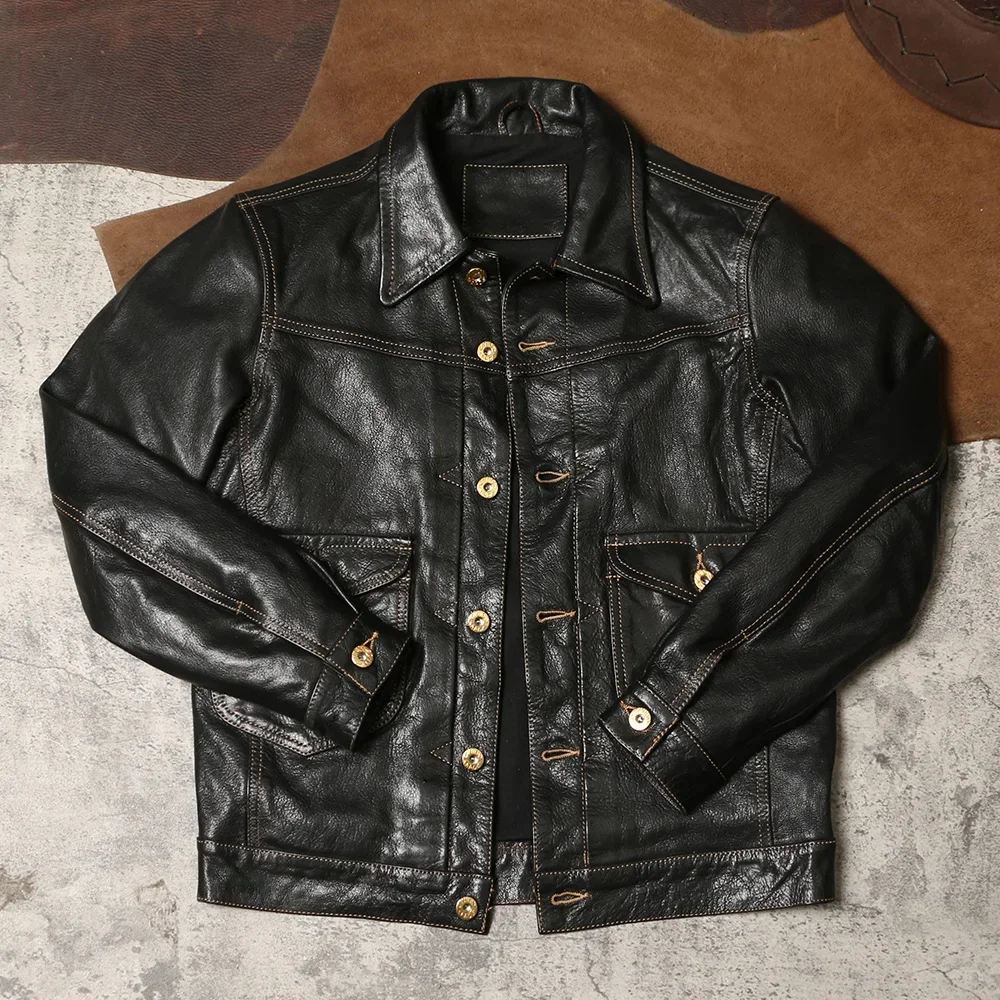
Proper care ensures your patterned coat maintains its distinctive appearance for years. Pattern definition relies on the integrity of the fabric structure, making proper maintenance essential.
For wool patterned coats, brush regularly with a clothing brush in the direction of the nap to remove surface dirt and prevent particle buildup that can dull the pattern’s appearance. Hang your coat on a properly sized, sturdy wooden hanger that supports the shoulders to maintain structure and prevent pattern distortion.
Herringbone coats benefit from occasional steaming rather than frequent dry cleaning, as the steam refreshes the pattern’s definition without harsh chemicals. For plaid coats, proper folding along pattern lines when storing can help maintain crisp pattern definition.
Seasonal storage requires breathable garment bags in cool, dry places—never store wool coats in plastic, which can trap moisture and damage the fabric’s structure. Cedar blocks or lavender sachets deter moths naturally without damaging fibers.
For both patterns, address spills or stains immediately by blotting (never rubbing) and seeking professional cleaning for persistent issues. Understanding the relationship between short versus long coats can also inform proper care techniques, as length affects how coats should be stored and maintained.
Professional cleaning is recommended at season’s end, but choose cleaners experienced with quality wool outerwear to avoid damaging the pattern’s definition.
Is Pattern Mixing Possible? Advanced Style Considerations
Pattern mixing with herringbone or plaid coats requires understanding scale relationships and color coordination. When done thoughtfully, it creates sophisticated, layered looks.
Herringbone coats, with their subtle texture, mix more easily with other patterns. They pair well with pinstriped suits, subtly patterned scarves, or textured knits because herringbone functions almost like a neutral from a distance. The key is maintaining sufficient contrast between pattern scales.
For plaid coats, successful pattern mixing is more challenging but possible. The rule of scale variation is essential: pair large-scale plaids with small-scale secondary patterns (like a fine pinstripe shirt or small polka dot tie). Additionally, ensure secondary patterns contain colors found in the plaid itself.
Color coordination becomes particularly important in pattern mixing. Identify a common color between your patterned coat and the secondary pattern to create visual cohesion. For instance, a navy and green tartan coat can work with a shirt featuring a small-scale pattern containing either navy or green elements.
Understanding the relationship between patterns and men’s coat length can enhance your pattern mixing strategy, as proportion affects how patterns interact visually.
Beginners to pattern mixing should start conservatively—try a herringbone coat with a subtly textured scarf before attempting more complex combinations.
Can Herringbone and Plaid Go Out of Style?
Both herringbone and plaid have demonstrated remarkable staying power across fashion history, though with different trajectories of prominence. These patterns have transcended decades because they balance character with versatility.
Herringbone maintains particularly consistent relevance due to its subtle sophistication. Its understated nature means it rarely looks dated, even as other fashion elements evolve around it. Classic gray or navy herringbone coats purchased today will likely remain stylish for decades.
Plaids experience more variation in popularity, with certain varieties cycling in and out of trend status. However, classic plaids like Glen check and traditional tartans maintain perennial appeal. More distinctive or colorful plaids may experience stronger trend cycles but often return to favor regularly.
The key to longevity lies in choosing classic expressions of either pattern—neutral colors, traditional scales, and quality materials ensure your coat transcends seasonal trends. Understanding how materials affect appearance can further enhance longevity, as quality wool construction dramatically affects how patterns wear over time, similar to how merino wool compares to regular wool in performance and appearance.
Metro Cloak specializes in these timeless patterns precisely because they represent lasting value rather than momentary trends—an investment in either pattern, thoughtfully selected, rewards you with years of sophisticated style.

